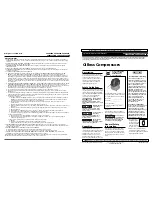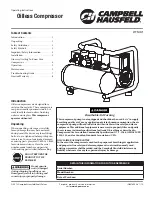
SKU 40400
For technical questions, please call 1-800-444-3353.
Page 5
Compressor Operation (continued)
Caution: The pressure switch is adjustable but changes to the pressure levels are not recommended;
any change to the automatic On/Off pressure levels will cause additional stress on the motor which
may result in shortened motor life.
Using the Safety Valve
The Safety Valve (see illustration on page 6 for location) is used when decompression is needed quickly and
efficiently.
1.
Press the ON/OFF switch down.
2.
Pull on the Safety Valve ring to release pressure.
Empty Air and Condensation
The Petcock (#53) release valve is located underneath the Tank Assembly (#50). It must be used daily to
release all trapped air and moisture through this valve. It will also get rid of any condensation that may cause
tank corrosion.
Warning
: Do not open the Petcock (#53) so that more than four threads are showing.
1.
Push down on the ON/OFF switch to turn the compressor off.
2.
Unscrew the Petcock (#53) two to three turns.
3.
When all pressure is released, close the Petcock (#53) again.
Warning:
To reduce the risk of fire or explosion, never spray flammable liquids in a
confined area. Always operate the compressor in a well ventilated area. Do not smoke
while spraying. Do not spray where sparks or flames are present. Keep compressor as
far from spray area as possible.
Never directly inhale the compressed air produced by a compressor. It is not
suitable for breathing purposes.
Never weld on the air tank of this Compressor. Welding of the tank could affect
tank strength and result in an extremely hazardous condition.
To avoid the potential for electric shock, never use this Compressor outdoors
when it is raining, and never use the Compressor on a wet surface.
Never point any nozzle or sprayer toward a person or animal.
NOTE: IF THE COMPRESSOR SUDDENLY SHUTS OFF, check and reset the unit’s
Overload Protection (59). To reduce the chance of this occurring, eliminate the
use of an extension cord.
REV 01/06


























